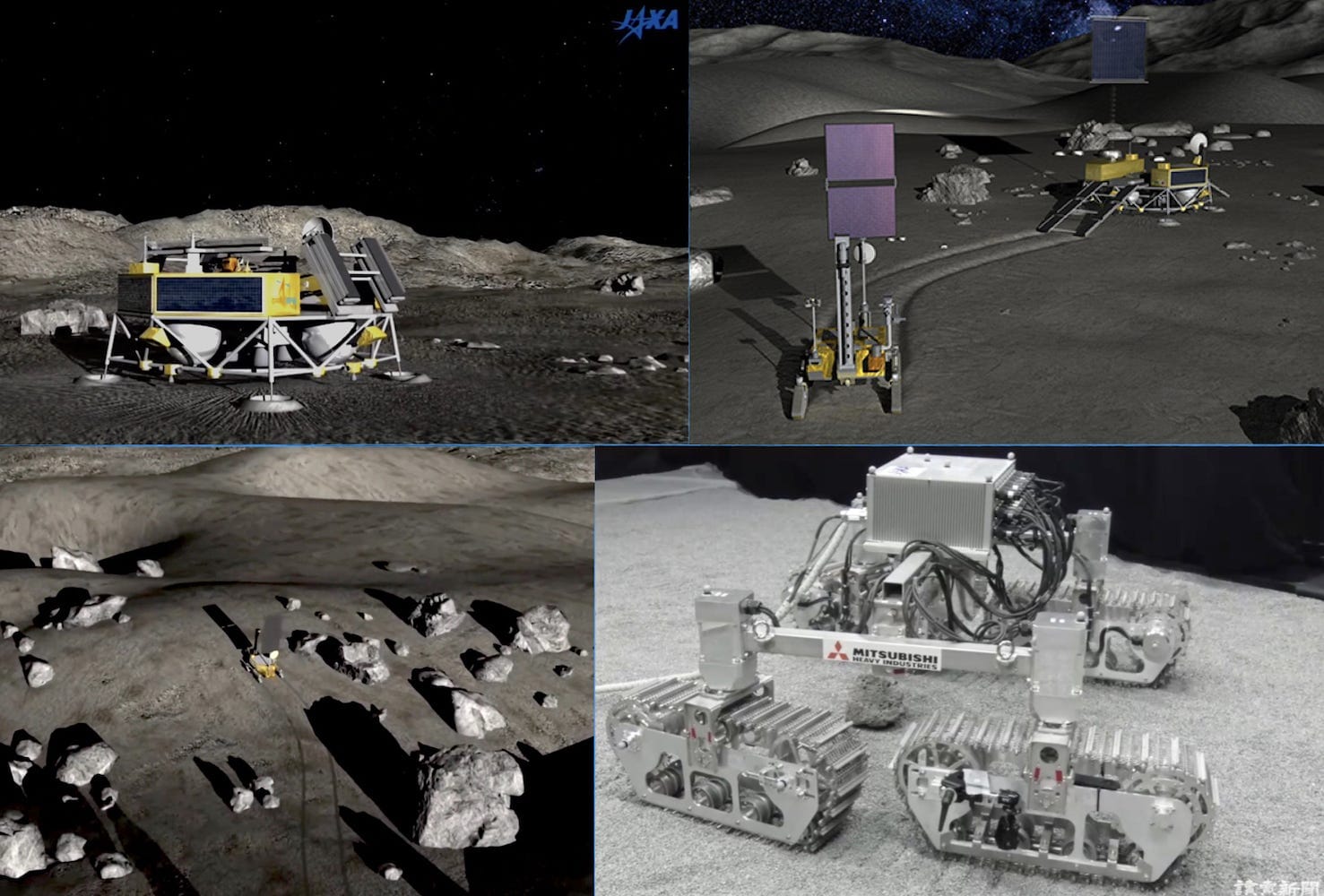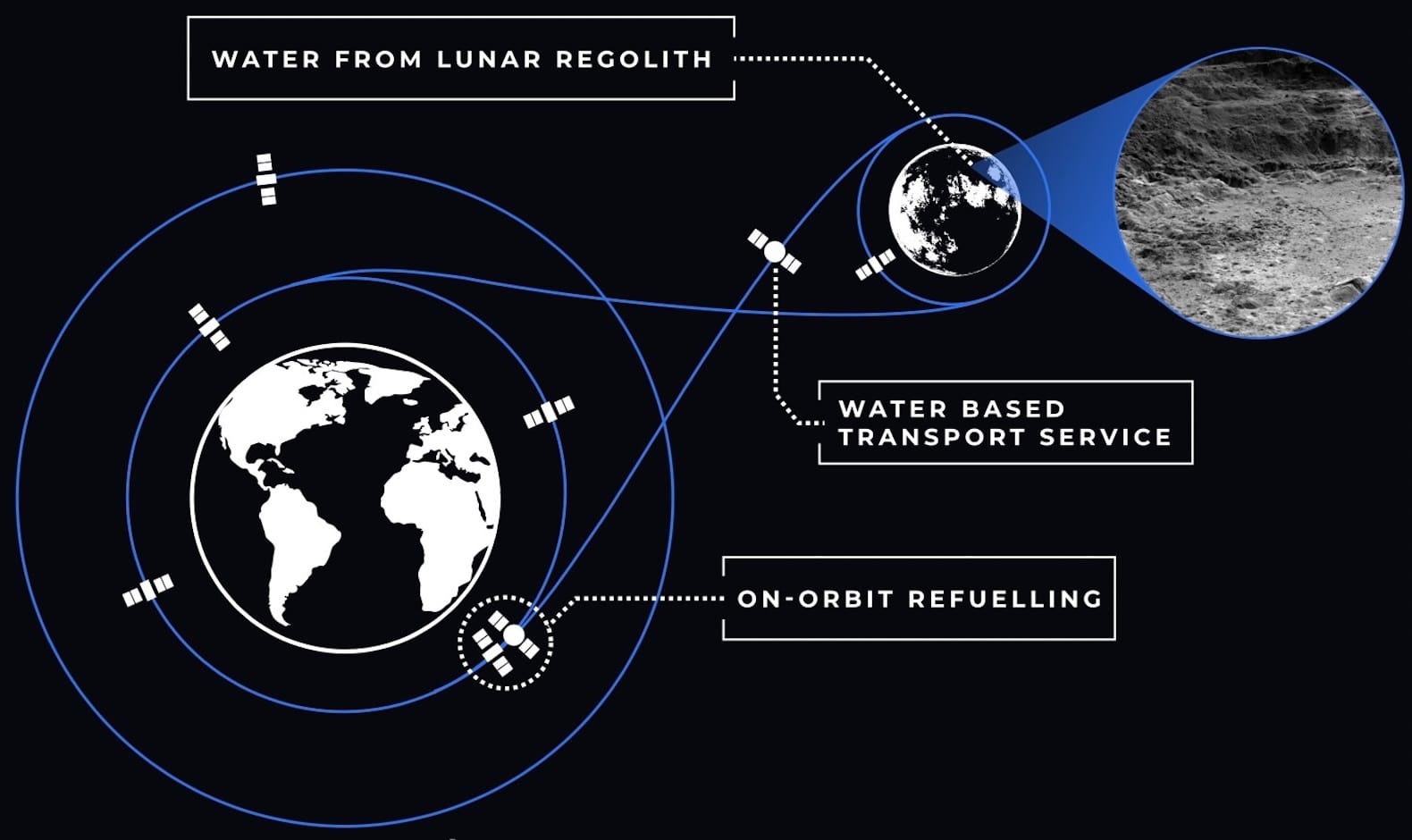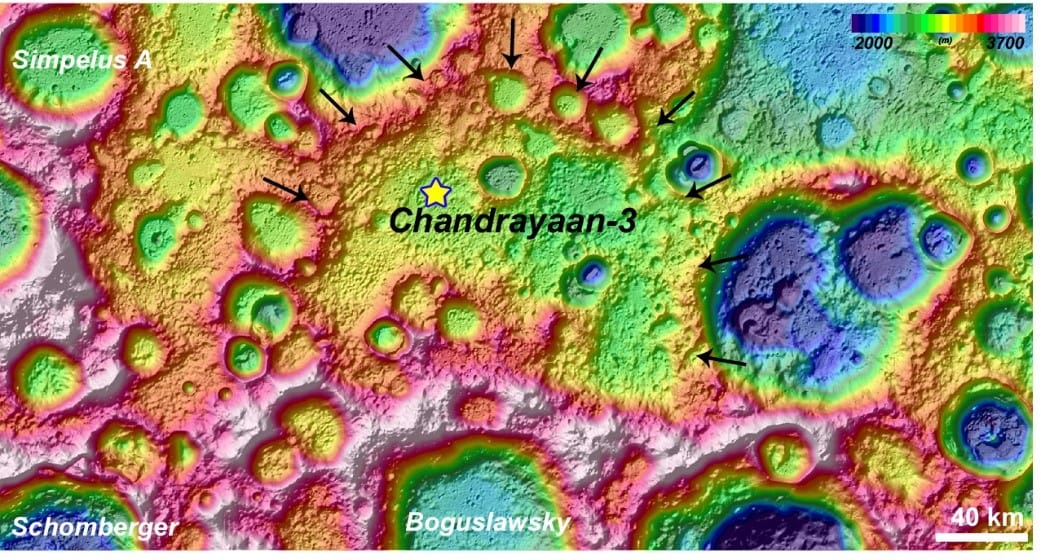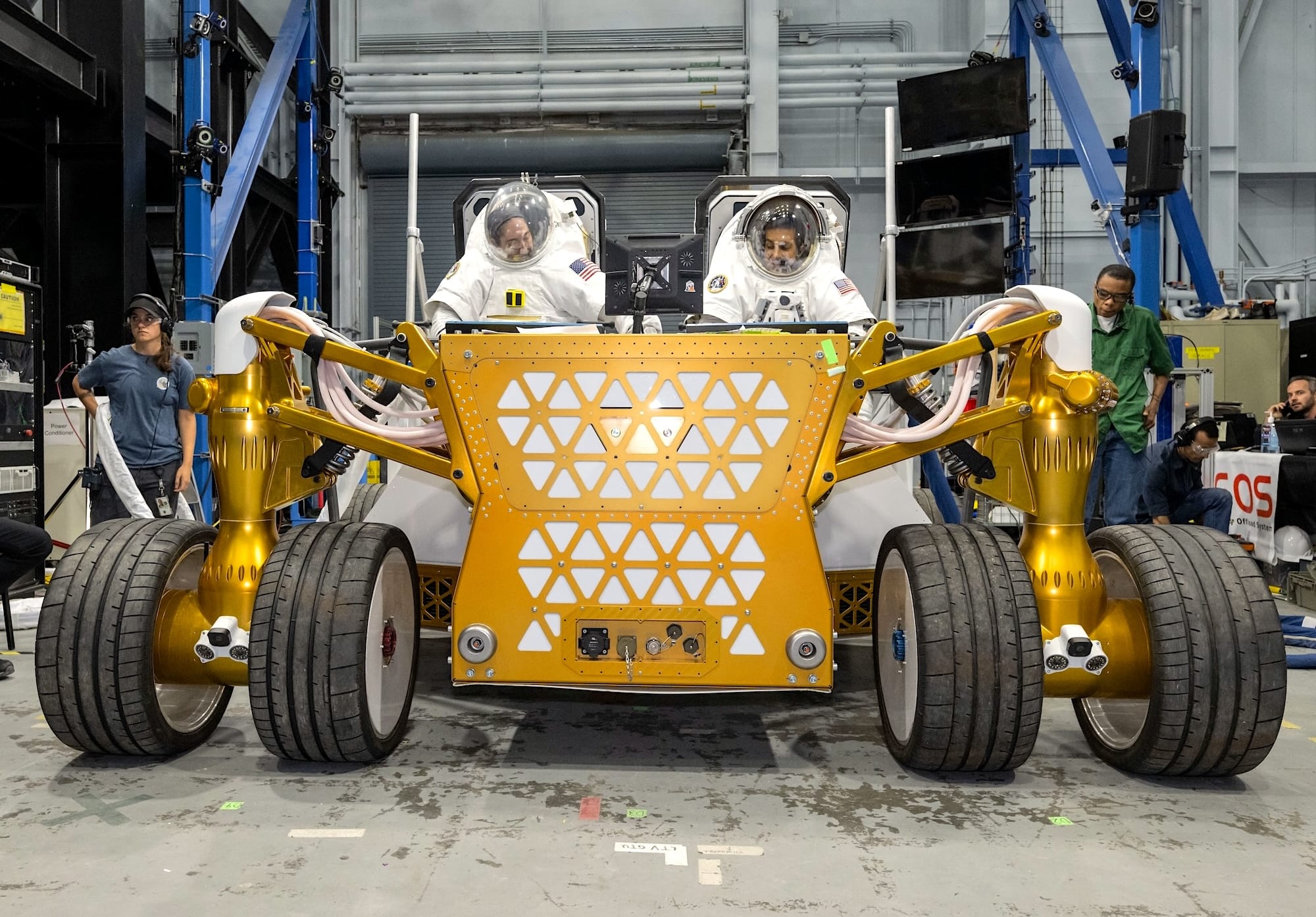Moon Monday #196: Confusion about lunar water and LUPEX, and papers plus mission updates
You can now follow my articles on some non-questionable social networks that also federate (interoperate): Flipboard, Mastodon and Bluesky.
The hunt for water on the Moon continues

US researchers find that permanently shadowed regions up to 77° latitude—which is outside the Moon’s south pole—could host surface and near-surface water ice, thereby expanding the presence of such regions farther than previously expected. This result is based on evaluating neutron detections by the Russian LEND instrument onboard NASA’s Lunar Reconnaissance Orbiter (LRO). Such neutron spectrometers infer presence of water ice in lunar soil by detecting certain neutrons released to space which likely have interacted with hydrogen atoms that are water-bound. Based on the findings, the researchers have also provided an updated map of coldest, poleward facing areas within permanently shadowed regions which are most likely to host water ice deposits.
This result complements two more recent results regarding lunar water:
- A recent study led by Indian scientists which combined optical, radar, neutron, and other data from LRO, and complemented it with the ISRO Chandrayaan 2 orbiter’s dual-frequency radar observations, estimated that the Moon’s poles host five to eight times more water ice 1-3 meters underground than near the surface. They also found that the extent of this water ice appears to be about twice as much on the lunar north pole than south. The authors also suggested that the Moon’s past volcanism is the primary source of this subsurface water ice but not all researchers agree.
- In 2020, US researchers using LRO data identified permanently shadowed regions inside craters that were smaller than a kilometer. They argued how micro cold traps within them, defined as being frigid enough to host water ice, increase the expected amount of lunar water deposits by at least 10–20% due to the substantial volume of such small craters.
On the other hand though, optical imaging of polar permanently shadowed regions by NASA’s ultra-sensitive ShadowCam imager onboard South Korea’s KPLO lunar orbiter has found no reflectance differences that can be uniquely attributed to surface water ice in most of the areas it has mapped so far.
The search for lunar water ice is thus far from settled. Ultimately, other than follow-up orbital observations by the likes of the NASA-funded Lunar Trailblazer orbiter, comprehensive surface missions dedicated to directly finding and studying lunar water ice are necessary to really know Luna’s nature. For this decade, such surface missions currently include CNSA’s upcoming Chang’e 7 mission and the JAXA-ISRO LUPEX rover. On the US side, there’s an ongoing scramble to save NASA’s water-studying VIPER rover mission from getting canceled against budgetary challenges.
The actual status of LUPEX

There has been a lot of confusion recently about the status of the JAXA-ISRO LUPEX rover mission intended to directly study the nature, accessibility, and abundance of water ice at the Moon’s south pole. So let me try to set some things straight per the best of my understanding of an evolving situation:
- The Indian National Space Commission approved LUPEX as of August 2024, which means advanced developmental work on the ISRO-provided lander for the mission can now take place as feasible. This does not mean LUPEX is fully approved for launch. Since it’s an international collaboration mission, the Indian Government Union Cabinet green-lighting the project is still necessary. (The Japanese government has already approved the mission on their end.)
- As suspected, Chethan Kumar reports based on an interview with the ISRO Chief S. Somanath that the agency is in the process of trying to get Union Cabinet approval for LUPEX but the Chandrayaan 4 sample return mission was put forward and authorized first.
- Even if LUPEX also gets approved soon, the spending required to proceed swiftly on its large lander development will not come out of thin air considering the continuing flat ISRO budgets. Chandrayaan 4 having gotten cabinet approval priority means its development, which is very complex, will take precedence over LUPEX wherever needed. Indeed, the ISRO Chief has now said that Chandrayaan 5/LUPEX will launch after Chandrayaan 4, confirming my argument last month about how ISRO swapped LUPEX’s launch order with Chandrayaan 4 due to programmatic and budgetary constraints.
- My speculation: Since Chandrayaan 4 is more complex, one way a cabinet-approved LUPEX might launch before Chandrayaan 4 is if the latter faces more technical hurdles owing to its sheer complexity while LUPEX finishes developmental milestones first. The nominal plan though is to launch Chandrayaan 4 first.
Lunar water startups

The lack of tactile confirmation of water deposits on the Moon’s poles hasn’t stopped startups from planning and raising money to build hardware that can extract and utilize this possible resource.
- With the latest funding raise of $7.9 million, Argo Space joins a host of new startups aiming to sell services based on lunar water. Argo Space wants to offer water-fueled space tug satellites based on extracted lunar water as an Earth-Moon transportation offering. Argo Space says it’s gearing up for its first Argonaut demonstration mission in 2025 but has not identified a launch vehicle or lander.
- Relatedly, Interlune—a startup founded over three years ago by several former Blue Origin employees—raised $15.6 million to develop lunar resource extraction technologies. Interlune is particularly focused on developing an efficient method to sort lunar material by particle size, which in turn would allow faster passing over of feedstock into systems that extract oxygen on the Moon. The company also says it wants to wants to mine Helium-3 on the Moon.
- Starpath Robotics, which has raised almost $15 million, also says it has big plans to mine lunar water and soil, extract oxygen from them, and then sell processed liquid oxygen to companies planning to regularly operate hardware at the Moon. The latter could include, after end of decade, Blue Origin with its Blue Moon lander as well as SpaceX with its upgraded Lunar Starship. The company is currently building terrestrial demonstrations of their envisioned mining system ahead of building hardware for Luna.
Many thanks to Off Planet Research and Paul Savio for sponsoring this week’s Moon Monday! If you too appreciate my efforts to bring you this curated community resource, kindly join them and support my independent writing.
More papers

- Researchers from the ISRO-affiliated PRL institute have published a paper positing that Chandrayaan 3’s landing site lies on top of an ancient crater which spans about 160 kilometers across and is up to 4.4 kilometers deep. This inference is primarily based on ejecta trails around the landing site as imaged by the mission’s Pragyan rover coupled with high-resolution views of the larger region from the Chandrayaan 2 orbiter. Scientists think the crater is well over four billion years old, and has been filled with material ejected from subsequent crater-forming impacts in the south polar region. These deposits include swaths of possible mantle material displaced here by the gigantic impact that formed the South Pole-Aitken basin south of the Chandrayaan 3 landing site.
- PRL researchers have also published a correlation of the April–May 2020 global COVID-19 lockdown with notable dips in temperatures on the Moon—as measured for six locations across the lunar nearside. The researchers have not been able to associate the temperature drops with solar activity or other sources so far.
More Moon
- Progress continues slowly on the NASA-led Gateway lunar orbital habitat. After going through a series of structural stress tests in April, the Gateway’s HALO habitat module has now passed static load testing, which checks how well the module’s structure responds to the mechanical forces when around the Moon. Technicians will outfit HALO’s components and subsystems once the module is shipped to the US from Italy after completing all tests. A recent report from the US Government Accountability Office (GAO) says Gateway’s launch will be as late as December 2027 instead of September 2025, confirming Philip Sloss’ reporting from May 2024.
- NASA’s Johnson Space Center is developing a terrestrial crewed rover prototype, called the Ground Test Unit (GTU), to enable NASA and the three competing commercial teams to better develop the versatile Lunar Terrain Vehicle (LTV) for Artemis. The GTU will act as an engineering tested, helping evaluate the eventual LTV rover’s operations, crew accommodations, maintenance, and how its scientific payloads can be integrated and operated.

